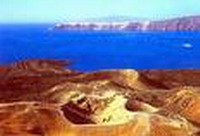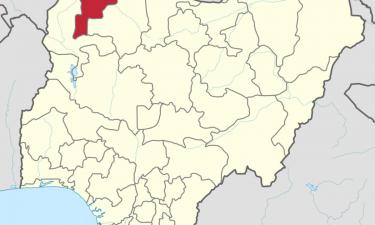Lava comes from Greek volcano to Sinai
White stones of pumice that a tsunami in ancient times carried 850 kilometers (530 miles) across the Mediterranean to north Sinai were presented by Egyptian archaeologists.

The pumice was discharged by a volcanic eruption in the ancient Greek island of Santorini in the 17th century B.C. Traces of this solidified lava foam that floats have been found in Crete and southwestern Turkey, but Egypt's archaeologists believe it also reached this site in the Sinai desert, about 7 kilometers (4 miles) south of the coast.
The Santorini explosion was devastating. It sunk most of the island and killed over 35,000 people of a thriving Minoan community.
The head of Egypt's Supreme Council of Antiquities, Zahi Hawass, hailed the discovery as opening a "new field" of study in Egyptology.
"Geologists will help us study how ... natural disasters, such as the Santorini tsunami, affected the Pharaonic period."
A volcanologist at Greece's Institute of Geology and Mineral Exploration, Georges Vougioukalakis, is skeptical that the pumice could have traveled so far. But "thin strata of ash" - carried by the wind from Santorini - have already been found in the Nile Delta, he told The Associated Press.
"The tsunami could have carried pumice a bit higher than the coastal area. But it would have been carried there by currents," Vougiokalakis said in Athens.
Some believe that Santorini could even be the elusive Atlantis, the mythical land described by Plato that disappeared without a trace.
But the myth of Atlantis was not on the mind of the archeologists when they excavated this desert site northeast of Qantara, a town on the Suez Canal about 150 kilometers (93 miles) northeast of Cairo.
They were searching for Pharaonic forts that played a major role in protecting ancient Egypt's gateway to the Nile Delta from foreign invasion.
They were gratified when, earlier this month, they uncovered the remains of an 18th dynasty fort, which featured four rectangular towers built of mud bricks.
"The pieces of lava stone were a surprise, but they were only part of the story," said team leader Mohamed Abdel Maqsud.
For the archaeologists, more significant was the discovery of a fortress from where the ancient Egyptians expelled the Hyksos enemy during the New Kingdom, a Pharaonic empire that lasted from about 1500 B.C. to about 1000 B.C.
The easternmost forts were so important that they were depicted in the reliefs on the walls of Karnak Temple in the ancient capital of Thebes - the present day city of Luxor, 500 kilometers (300 miles) south of Cairo. The 18th Dynasty was the first dynasty of the New Kingdom and its 12th ruler was the boy Pharaoh Tutankhamun.
Hawass did not elaborate on the geological tests that linked the Sinai pumice to Santorini, but said he was convinced that more such lava would be found.
"This is only the beginning," he said.
Vougioukalakis, who has extensively studied Santorini's eruption, said that if the pumice did come from there, it would be first evidence the tsunami had carried the lava so far.
Subscribe to Pravda.Ru Telegram channel, Facebook, RSS!





